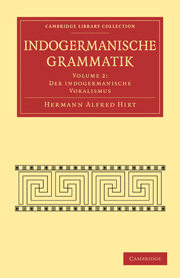Book contents
- Frontmatter
- Vorwort
- Contents
- Einleitung
- Erster Teil. Der Ablaut innerhalb der Silbe
- I Kapitel. Abstufung ei: i usw
- II Kapitel. Mannigfaltigkeit des idg. Vokalismus. Die Vokale e, a, o
- III Kapitel. Die langen Vokale
- IV Kapitel. Die Dehnstufe (D)
- V Kapitel. Die Langdiphthonge
- VI Kapitel. Die Reduktionsstufe (R)
- Zweiter Teil. Der Ablaut mehrerer Silben
- Dritter Teil. Ergänzende Fragen
- Wörterverzeichnis
- Umschreibung
- Abkürzungen
- Berichtigungen
VI - Kapitel. Die Reduktionsstufe (R)
Published online by Cambridge University Press: 05 February 2015
- Frontmatter
- Vorwort
- Contents
- Einleitung
- Erster Teil. Der Ablaut innerhalb der Silbe
- I Kapitel. Abstufung ei: i usw
- II Kapitel. Mannigfaltigkeit des idg. Vokalismus. Die Vokale e, a, o
- III Kapitel. Die langen Vokale
- IV Kapitel. Die Dehnstufe (D)
- V Kapitel. Die Langdiphthonge
- VI Kapitel. Die Reduktionsstufe (R)
- Zweiter Teil. Der Ablaut mehrerer Silben
- Dritter Teil. Ergänzende Fragen
- Wörterverzeichnis
- Umschreibung
- Abkürzungen
- Berichtigungen
Summary
100. Die Reduktionsstufe im allgemeinen. Mit der Entdeckung der silbischen Liquiden und Nasale war das Verständnis des indogermanischen Ablauts auch nach der Seite der Schwundstufe noch nicht abgeschlossen, und man muß offen eingestehen, daß sich die beiden Führer in dieser Bewegung, Brugmann und Osthoff, leider auf ganz falsche Bahnen verlocken ließen. Der Grund liegt darin, daß sie sich von einer ziemlich mechanischen Auffaseung der Sprache nicht freimachen konnten.
Zunächst zeigte sich nämlich, daß neben den j und w der Einzelsprachen nicht selten ij und uw standen. So vor allem im Indischen, wo sich neben djāus auch dijāus findet. Und ähnliche Fälle gibt es eine Menge. Man nahm zur Erklärung nach dem Vorgang der indischen Grammatik an, daß das j silbisch geworden und einen Übergangslaut entwickelt habe. Dieser Übergangslaut, der sich nach i und u einstellen soil, spukt noch immer in der Wissenschaft. Man muß ihm indessen ein großes Mißtrauen entgegenbringen. Zwar lassen sich Beispiele dafür beibringen, daß ein j silbisch wurde und umgekehrt. Z. B. entspricht dem ai. mádhjas ‘mitten’, gr. μ∈σoς, got. midjis ein l. medius, das sicher als dreisilbig aufzufassen ist, während ital. mezzo wieder auf ein zweisilbiges medjo zurückweist. Dieser Vorgang ist also belegt, wenngleich von einem j als neuentwickeltem Übergangslaut hier so wenig wie in vielen andern Fällen zu spüren ist.
- Type
- Chapter
- Information
- Indogermanische Grammatik , pp. 76 - 102Publisher: Cambridge University PressPrint publication year: 2009First published in: 1921



